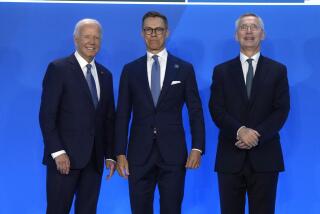U.S., Soviets Talk of Gulf Defense Pact : Alliance: The proposed security organization would be the first since World War II to include both superpowers.
- Share via
MOSCOW — Secretary of State James A. Baker III and Soviet Foreign Minister Eduard A. Shevardnadze opened talks Tuesday about creation of a regional security structure to contain Iraqi President Saddam Hussein and his potent military machine if the Persian Gulf crisis ends peacefully.
A senior State Department official said planning is still in a preliminary stage. But both Washington and Moscow agree that some new mechanism will be required to prevent Iraq from launching new Kuwait-style aggression if the crisis is resolved without the destruction of Hussein’s army and its arsenal of chemical weapons.
The official said the new organization would combine the Arab nations of the gulf region with some outside powers, almost certainly including the United States and the Soviet Union.
It would be the first regional security organization since World War II to include both nuclear superpowers. Previous alliances have been either U.S.-led organizations to restrain the Soviet Union or Soviet-run organizations to combat the United States.
President Bush and Soviet President Mikhail S. Gorbachev agreed during their weekend summit meeting in Helsinki, Finland, to tighten the economic embargo on Iraq in an effort to pressure Baghdad into peacefully ending its occupation of Kuwait. But they acknowledged that such a solution would not ensure lasting peace unless powerful new restraints are placed on Iraq.
Egyptian President Hosni Mubarak, voicing concerns that have been expressed privately by other Arab leaders, said Saturday that peace will be unstable as long as Iraq maintains its chemical weapons and its emerging capacity to produce nuclear arms. Mubarak implied that it would be necessary to defeat Hussein militarily in order to prevent future Iraqi aggression.
“If the diplomatic strategy is successful, you have to consider the consequences of success,” the State Department official said Tuesday after Baker’s 3 1/2-hour meeting with Shevardnadze.
Baker first suggested creation of an alliance to contain Iraq last week in an appearance before the House Foreign Affairs Committee. At that time, he compared his idea to the North Atlantic Treaty Organization, the 16-nation alliance of European and North American nations that anchored Western security during the long Cold War.
Saudi Arabia, Washington’s key ally in the gulf, balked at the analogy. Saudi officials said NATO was far too structured and too intrusive to be transplanted to the gulf region.
Although Baker backed away from the NATO comparison, U.S. officials said the proposed structure would have to be potent enough to counteract the Iraqi army, by far the largest and best equipped in the region.
By drawing Shevardnadze into the discussion, Baker demonstrated the post-Cold War relaxation of Washington’s previous determination to minimize Soviet influence in the Middle East.
The Bush Administration abandoned Washington’s traditional aversion to a Soviet role in the region months ago, but the United States had not previously suggested a regional alliance that would embrace both superpowers.
The Soviet Union has long been an ally of Iraq and its largest arms supplier. But it cut off weapons shipments after the Aug. 2 invasion of Kuwait. About 190 Soviet specialists remained, however, training Iraqis in the use of military equipment. Gorbachev said at the summit Sunday that the number had fallen to about 150 and would keep dropping as their contracts expired.
Shevardnadze told Parliament on Tuesday that the Soviet military advisers were kept in Iraq partly for fear that their departure would jeopardize the 5,800 Soviets still there.
“If the contracts are not fulfilled by our side, that will concern not only our military specialists, but also a very large group of civilian specialists,” the foreign minister said.
He said that Baghdad has allowed Moscow to evacuate nearly 3,000 Soviet citizens, including all 883 from Kuwait, all 274 children from Iraq and most of the 699 women from Iraq. He said that 5,800 people, most of them men engaged in civilian projects, remain.
Baker and Shevardnadze also sought to complete issues that were left unfinished by Bush and Gorbachev during their one-day Helsinki summit.
U.S. officials said the foreign ministers addressed, but did not resolve, a new dispute over the numbers of American troops that may be stationed in Western Europe after the withdrawal of Soviet forces from the previously Communist nations of Eastern Europe. The issue could undermine efforts to complete a new treaty on conventional forces in Europe before the end of this year.
Washington and Moscow agreed earlier this year to fix a ceiling of 195,000 Soviet and 225,000 American troops in Europe. However, Moscow later bowed to the demands of the new non-Communist regimes in Eastern Europe and agreed to withdraw all of its forces within four years.
Moscow now is calling for sharp reductions in the previously agreed level of U.S. forces.
More to Read
Sign up for Essential California
The most important California stories and recommendations in your inbox every morning.
You may occasionally receive promotional content from the Los Angeles Times.












